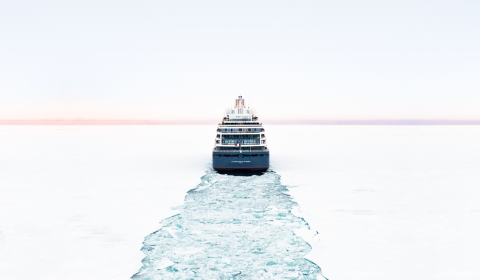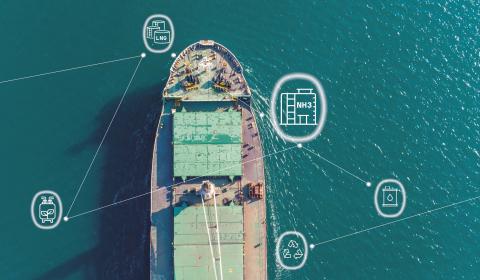
Ponant and Bureau Veritas: partners for sustainable cruising
With a capacity of 245 passengers and 215 crew, Le Commandant Charcot. invites guests to explore breathtaking polar regions from the comfort of a luxury cruise ship. We met with Mathieu Petiteau from Ponant to discuss this first high polar exploration ship. On the agenda: Ponant’s ambitious sustainability objectives, the ship’s performance during its first Antarctic season in 2021 and the importance of Ponant’s strong partnership with Bureau Veritas.
What was Ponant’s overall ambition in developing LE COMMandant charcot?
In 2015, we embarked upon the development of Le Commandant Charcot, an homage to French explorer Jean-Baptiste Charcot. To navigate the sensitive polar regions, we needed to use all the technology available on the market to minimize our impact on the environment. The Polar Code guided our alternative design focusing on sustainability and a luxury passenger experience. I’m not alone in saying it was the most sophisticated vessel I have ever worked on. At the shipyard, it was fondly referred to as “the spaceship”!
How did you engineer the design to improve sustainability?
Firstly, we opted for the greenest fuel available at the time—liquified natural gas (LNG). This represented a risk: not only had LNG never previously been used on board cruise vessels, but LNG supply chains were underdeveloped at this time. There was therefore no guarantee of being able to refuel in polar regions. The limited hull size also posed a technical challenge. To maximize capacity, we opted for a membrane tank, a first for cruise ships, which typically rely on Type C storage. This solution increased tank capacity and helped us reach the autonomy of up to two months that we needed in polar regions where there is no bunkering infrastructure available. With support from our partner, Bureau Veritas, we approved LNG as a safe and viable solution.
Alongside LNG, we integrated a high-capacity battery system to optimize fuel consumption. The batteries enable us to run zero-emission cycles, which improve fuel efficiency. By charging the batteries when the engine is running, we can then cut the engine for around an hour and run solely on battery power. We also switch to battery use near marine wildlife to minimize noise and protect the surrounding environment. The lack of rules surrounding battery integration aboard cruise vessels represented quite a challenge, but Bureau Veritas assisted us with a thorough risk analysis.
What are the other innovations aboard Le Commandant Charcot?
For Le Commandant Charcot, we developed sophisticated ice routing software. It uses satellite images and ice maps from the American National Oceanic and Atmospheric Administration to give us a dynamic view of ice coverage and thickness, with accuracy within one centimeter. Our software then identifies the best route to take to minimize fuel consumption.
For PONANT, sustainability is also about everything we can do on board. With this in mind, we introduced an innovative water filtration system. Using reverse osmosis and a filter system to improve taste, we have phased out plastic bottles on board. Passengers are served still and sparkling water from glass bottles only.
How important was the Safety and Rescue Exercise (SAREX) of September 2021 carried out with Bureau Veritas?
The SAREX was quite a milestone for Le Commandant Charcot. Explorers usually train for weeks before a polar expedition. We have to demonstrate to the flag that we can evacuate the vessel with 460 persons in any condition and survive during 5 days in polar waters, on ice or on land. This is a requirement of the Polar Code. It was up to us to develop and build equipment to make this possible since nothing existed on the market. We have organized this Search and Rescue Exercise with volunteers and observers like different national coast guard representatives, and a mix of crew and test passengers. The SAREX proved an overwhelming success and gave us real-world experience to build upon.
How has Le Commandant Charcot been performing since its maiden voyage in November 2021?
Le Commandant Charcot has been exceeding expectations. We were delighted to discover that we had overestimated fuel consumption. Since we’re using existing natural channels in the ice, and the hotel load from accommodation is lower than expected, we are consuming less energy than planned.
The vessel is designed to function in temperatures of -25°C, yet when we first set sail to the North Pole, we only experienced -12°C to -15°C. Recently, however, we had the opportunity to test the ship in -27°C and it performed very well. The safety equipment worked correctly and the de-icing system prevented installations from freezing. We’re extremely satisfied with the ship’s performance so far.
What has been the feedback from passengers?
We have had nothing but positive feedback from our guests. I was on board for the first cruise and passengers were very emotional. They felt the accommodation and level of service rival that of a luxury yacht, and were overwhelmed by the stunning landscapes and incredible experiences on offer to them. Le Commandant Charcot is a resounding commercial success.
One of Ponant’s priorities is to increase sustainable expedition opportunities. We hope to welcome more expedition leaders aboard to share valuable knowledge and experience with our passengers while making every effort to limit our environmental footprint.
How has Bureau Veritas supported you throughout the project?
Bureau Veritas assisted us from the initial design phase. From our studies, we knew the vessel needed to be built to Polar Class 2. Since the ship can move both forwards and backwards in the ice, Bureau Veritas advised us on assigning Icebreaker 3 fore and Icebreaker 4 aft service notations.
The Bureau Veritas team helped us define the working package in terms of risk analysis, since there were so many innovations. They supported us in studies relating to LNG storage tanks, bunkering and batteries, among other things. Once we had developed the alternative design, BV guided us through the approval processes.
As a fellow French company, PONANT has a close working relationship with Bureau Veritas. I personally spent two months in the Paris office working on risk analysis, which was a very positive experience. Their experts are highly skilled and we have felt fully supported throughout the project.
How do you see the future of cruising?
PONANT’s goal is to build zero-emission cruise vessels, in partnership with Bureau Veritas. We have learnt a huge amount in terms of hybrid technology and LNG which will serve us for future vessels.
I see a bright future for cruise, but with a different commercial model. Cruising will need to become more conscious of the environment. Current fixed arrival and departure times have a direct effect on speed and therefore fuel consumption and environmental impact. To limit CO2 emissions, timings will have to be flexible with a redesigned onboard offer to compensate. The future of cruising is certainly sustainable.
Bureau Veritas is proud to be contributing to the development of sustainable ships like Le Commandant Charcot, reaffirming our commitment to Shaping a Better Maritime World.
YOU MAY ALSO LIKE










